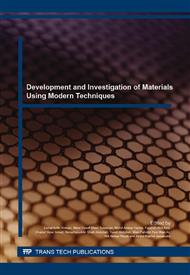[1]
C.Y. Chen, Y.R. Lyu, Effect of NiO addition on properties of bulk yttria-doped ceria sintered from their spray pyrolyzed powder, Ceram. Int. 38(4) (2012) 3291-3300.
DOI: 10.1016/j.ceramint.2011.12.036
Google Scholar
[2]
A.U. Chavan, L.D. Jadhav, A.P. Jamale, S.P. Patil, C.H. Bhosale, S.R. Bharadwaj, P.S. Patil, Effect of variation of NiO on properties of NiO/GDC (gadolinium doped ceria) nano-composites, Ceram. Int. 38(4) (2012) 3191-3196.
DOI: 10.1016/j.ceramint.2011.12.023
Google Scholar
[3]
H.A. Rahman, A. Muchtar, N. Muhamad, H. Abdullah, Structure and thermal properties of La 0. 6Sr0. 4Co0. 2Fe0. 8O3−δ–SDC carbonate composite cathodes for intermediate-to low-temperature solid oxide fuel cells, Ceram. Int. 38(2), 1571-1576.
DOI: 10.1016/j.ceramint.2011.09.043
Google Scholar
[4]
L. Zhang, R. Lan, C.T.G. Petit, S. Tao, Durability study of an intermediate temperature fuel cell based on an oxide–carbonate composite electrolyte. Int. J. Hydrogen Energy, 35(13) (2010) 6934-6940.
DOI: 10.1016/j.ijhydene.2010.04.026
Google Scholar
[5]
Y. Zhao, C. Xia, L. Jia, Z. Wang, H. Li, J. Yu, Y. Li, Recent progress on solid oxide fuel cell: Lowering temperature and utilizing non-hydrogen fuels. Int. J. Hydrogen Energy, 38(36) (2013) 16498-16517.
DOI: 10.1016/j.ijhydene.2013.07.077
Google Scholar
[6]
T. Misono, K. Murata, T. Fukui, J. Chaichanawong, K. Sato, H. Abe, M. Naito, Ni-SDC cermet anode fabricated from NiO–SDC composite powder for intermediate temperature SOFC, J. Power Sources 157(2) (2006) 754-757.
DOI: 10.1016/j.jpowsour.2006.01.074
Google Scholar
[7]
M. Kawano, H. Yoshida, K. Hashino, H. Ijichi, S. Suda, K. Kawahara, T. Inagaki, Synthesis of matrix-type NiO–SDC composite particles by spray pyrolysis with acid addition for development of SOFC cermet anode, J. Power Sources 173(1) (2007) 45-52.
DOI: 10.1016/j.jpowsour.2007.08.021
Google Scholar
[8]
Q. Liu, X. Dong, C. Yang, S. Ma, F. Chen, Self-rising synthesis of Ni–SDC cermets as anodes for solid oxide fuel cells, J. Power Sources 195(6) (2010) 1543-1550.
DOI: 10.1016/j.jpowsour.2009.09.071
Google Scholar
[9]
M.R. Somalu, V. Yufit, D. Cumming, E. Lorente, N.P. Brandon, Fabrication and characterization of Ni/ScSZ cermet anodes for IT-SOFCs, Int. J. Hydrogen Energy 36(9) (2011) 5557-5566.
DOI: 10.1016/j.ijhydene.2011.01.151
Google Scholar
[10]
S. Ohara, R. Maric, X. Zhang, K. Mukai, T. Fukui, H. Yoshida, T. Inagaki, K. Miura, High performance electrodes for reduced temperature solid oxide fuel cells with doped lanthanum gallate electrolyte: I. Ni–SDC cermet anode, J. Power Sources 86(1) (2000).
DOI: 10.1016/s0378-7753(99)00431-0
Google Scholar
[11]
F.S. Torknik, A. Maghsoudipour, M. Keyanpour-Rad, G.M. Choi, S.H. Oh, G.Y. Shin, Microstructural refinement of Ni/Ce0. 8Gd0. 2O2−δ anodes for low-temperature solid oxide fuel cell by wet infiltration loading of PdCl2, Ceram. Int. 40(8) (2014).
DOI: 10.1016/j.ceramint.2014.04.075
Google Scholar
[12]
S.Y. Park, C.W. Na, J.H. Ahn, R.H. Song, J.H. Lee, reparation of highly porous NiO–gadolinium-doped ceria nano-composite powders by one-pot glycine nitrate process for anode-supported tubular solid oxide fuel cells, J. Asian Ceram. Soc. 2(4) (2014).
DOI: 10.1016/j.jascer.2014.07.005
Google Scholar
[13]
T. Skalar, K. Zupan, M. Marinšek, B. Novosel, J. Maček, Microstructure evaluation of Ni–SDC synthesized with an innovative method and Ni–SDC/SDC bi-layer construction, J. Eur. Ceram. Soc. 34(2) (214) 347-354.
DOI: 10.1016/j.jeurceramsoc.2013.08.020
Google Scholar
[14]
H. Seon Hong, S. Lee, C. Sunyong Lee, Characterization of (Ni–Cu)/YSZ cermet composites fabricated using high-energy ball-milling: effect of Cu concentration on the composite performance, Ceram. Int. 41(4) (2015) 6122-6126.
DOI: 10.1016/j.ceramint.2014.12.158
Google Scholar
[15]
R. Jarot, A. Muchtar, W.R. Wan Daud, N. Muhamad and E.H. Majlan, Porous NiO-SDC carbonates composite anode for LT-SOFC applications produced by pressureless sintering, Appl. Mech. Mater. 52–54 (2011) 488-493.
DOI: 10.4028/www.scientific.net/amm.52-54.488
Google Scholar
[16]
I.A. Amar, C.T.G. Petit, L. Zhang, R. Lan, P.J. Skabara, S. Tao, Electrochemical synthesis of ammonia based on doped-ceria-carbonate composite electrolyte and perovskite cathode, Solid State Ionics, 201(1) (2011) 94-100.
DOI: 10.1016/j.ssi.2011.08.003
Google Scholar
[17]
L. Agun, H.A. Rahman, S. Ahmad, A. Muchtar, Influence of Binary Carbonate on the Physical and Chemical Properties of Composite Cathode for Low-Temperature SOFC, Adv. Mater. Res. 1087 (2015) 177-181.
DOI: 10.4028/www.scientific.net/amr.1087.177
Google Scholar
[18]
M. Chen, B. H. Kim, Q. Xu, O. J. Nam, J.H. Ko, Synthesis and performances of Ni–SDC cermets for IT-SOFC anode, J. Eur. Ceram. Soc. 28(15) (2008) 2947-2953.
DOI: 10.1016/j.jeurceramsoc.2008.05.009
Google Scholar
[19]
Y. Shilong, Y. Zhupeng, L. Chuanming, C. Xiaowei, Z. Yanwei, Theoretical description on the interface-enhanced conductivity of SDC/LiNa-carbonate composite electrolytes. Mater. Lett. 92 (2013) 78-81.
DOI: 10.1016/j.matlet.2012.10.062
Google Scholar
[20]
J. Coates, Interpretation of Infrared Spectra, A Practical Approach, in: Encyclopedia of Analytical Chemistry, John Wiley & Sons, (2000).
Google Scholar
[21]
Y. Jing, J. Patakangas, P.D. Lund, B. Zhu, An improved synthesis method of ceria-carbonate based composite electrolytes for low-temperature SOFC fuel cells, Int. J. Hydrogen Energy 38(36) (2013), 16532-16538.
DOI: 10.1016/j.ijhydene.2013.05.136
Google Scholar


